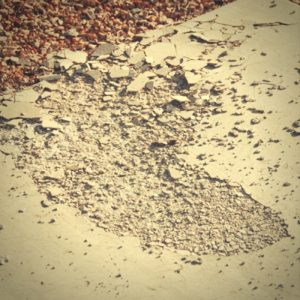How to Repair Concrete Spalling
Generally, concrete that flakes, breaks, or looses chunks is the result of a bad mixture during its original installation. This does not indicate that the whole area is liable to crumble, as often, concrete uses sand, cement mixture, gravel, and water, so clumps of sand that fail to break up or chunks of cement mixture that do not crumble well during the original mixing can provide for problems later.
If the concrete was poured with such mixture imperfections, extreme weather conditions and time can lead to eventual spalling. Heavy and constant rain, as well as snow, sleet, freezing temperatures, and very hot weather can all contribute to concrete flaking, breaking or cracking, and crumbling. Rusting metal under thin concrete can also cause it to break away.
Repair Concrete Spalling
Repair Concrete Spalling on Flat Ground
 Repairing imperfections resulting from breaking concrete on flat ground is fairly easy, presuming that a large volume of replacement is not needed to fill gaps, cracks, dents, or small craters. If cubic yards are needed, calling a concrete truck may be the right move, as bags of cement mix get expensive when they pile up.
Repairing imperfections resulting from breaking concrete on flat ground is fairly easy, presuming that a large volume of replacement is not needed to fill gaps, cracks, dents, or small craters. If cubic yards are needed, calling a concrete truck may be the right move, as bags of cement mix get expensive when they pile up.
To repair basic concrete deterioration, the following items are needed:
- Bag(s) cement mix
- Sand
- Gravel
- Water
- Wheel barrow or tub for mixing
- Shovel
- Trowel
To mix very small amounts of concrete for uses such as repairing cracks, only cement mix and water are needed. Using the trowel, stir water into the cement powder by folding the powder over as water is being lightly poured in. A thick, wet, but not runny consistency makes for the best cement. To repair cracks or small areas of loose or missing concrete, first remove any crumbled residue or dust by scraping out the area or blowing into it, with safety glasses on. Then, dab some freshly and thoroughly mixed concrete into the spaces, so that it is flush with the top of the original area, and allow it to dry.
If mixing larger amounts to repair larger areas of concrete spalling, use more powder, a little sand, and a little bit of gravel, which serve as aggregates to help hold the mixture together. Turn all of this over and stir it around several times using a shovel, while pouring in water, until a thick, wet consistency that looks like fresh ice cream results. Pour or scoop this into large cracks or holes after removing crumbled residue, and allow it to dry, flush with the top of the surrounding area.
If you instead need to repair mortar, check out this post to learn how to repair mortar joints
How to Repair Concrete Spalling on Vertical Structure
 Repairing imperfections on walls or ledges can be slightly trickier. The same materials are needed to make the mixture, and some plywood can also come in handy to keep concrete from peeling out of the pockets in the vertical sides in which it will be placed. Repairing cracks, however, is much easier than fixing up large holes in walls, and wood is usually not needed for this. To fix up cracks or small dents, mix the concrete, and then, holding the trowel with concrete on its bottom tip, scrape the mix into the creases. If it has been mixed well, it should set well; apply it liberally, and later, after it has hardened some, the excess may be easily scraped away with the trowel to make it flush.
Repairing imperfections on walls or ledges can be slightly trickier. The same materials are needed to make the mixture, and some plywood can also come in handy to keep concrete from peeling out of the pockets in the vertical sides in which it will be placed. Repairing cracks, however, is much easier than fixing up large holes in walls, and wood is usually not needed for this. To fix up cracks or small dents, mix the concrete, and then, holding the trowel with concrete on its bottom tip, scrape the mix into the creases. If it has been mixed well, it should set well; apply it liberally, and later, after it has hardened some, the excess may be easily scraped away with the trowel to make it flush.
To fix larger holes or dents in vertical structure, several mixings may be necessary. Plug the hole insofar as possible with the first batch, and then, if it attempts to peel out, place plywood firmly over the hole until it sets, with something leaning on the wood to keep it firm against the wall. Then, repeat with additional applications until the concrete spalling is fixed. Filling the hole is key here: as long as all of the empty space is filled with fresh concrete, it will turn out fine, as excess can be removed hours after the concrete has begun to set, to make the fresh part of the wall flush with the original structure.
Check Out: Simple Fixes for Common Household Problems
Learning how to fix up cracks, dents, holes, and crumbling areas in concrete structure does not take too much time or money, and knowing how to repair such imperfections is an essential part of one’s capability to perform basic household maintenance.


